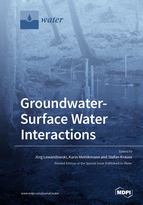Groundwater-Surface Water Interactions
A special issue of Water (ISSN 2073-4441). This special issue belongs to the section "Hydrology".
Deadline for manuscript submissions: closed (30 September 2019) | Viewed by 120270
Special Issue Editors
(2) Geography Department, Humboldt University Berlin, Berlin, Germany
Interests: groundwater–surface water interactions, hyporheic zones, lacustrine groundwater discharge, ecohydrology, biogeochemistry, bioturbation, lake restoration, urban water interfaces
Interests: lacustrine groundwater discharge, hydrological and geochemical processes at groundwater–surface water interfaces, nutrient dynamics and transport in catchments, quantification of mass loads to lakes with a focus on groundwater-borne phosphorus loads
Interests: reactive transport processes across aquatic–terrestrial interfaces; nutrient and carbon cycling; fate and transport of microplastics; distributed sensor networks; in-situ high-frequency sensor technologies; hyporheic zone processes
Special Issues, Collections and Topics in MDPI journals
Special Issue Information
Dear Colleagues,
Recent years have seen a paradigm shift in our understanding of the importance of the interactions between groundwater and surface water bodies: While for a long time surface waters and aquifers had been defined as discrete, separate entities, it is nowadays understood they are integral components of a surface-subsurface continuum. Although this paradigm shift triggered intense investigations of the water and mass transport processes across aquatic–terrestrial interfaces, and there is still a lack of mechanistic understanding and standardized methods with which to approach the processes involved. For example, it is well accepted that the reactive interface between surface water and the subsurface is of great importance for the quality and the quantity of exchange fluxes. However, experimental and validated model-based evidence of the magnitude of the involved processes, as well as of the underlying controls, is scarce. One of many reasons for this is that groundwater–surface water interactions integrate a large variety of scientific disciplines. Researchers from hydrology, biogeochemistry, microbiology, biology, physics, and chemistry work on the complex process interactions that require them to consider relevant aspects from other scientific fields. Additionally, interactions between surface and subsurface water take place in a range of different marine and freshwater systems, but the potential to transfer technologies and approaches, as well as the resulting knowledge and process understanding of other fields, has not been adequately exploited.
The aim of the present Special Issue is to integrate novel outcomes from interdisciplinary research on groundwater–surface water interactions, and to thus offer a platform with which to collectively present research outcomes on groundwater–surface water interactions without the restrictions of scope, scale, and scientific field. Experimental, modelling, or conceptual studies on river, lake, and marine ecosystems and their interactions with underlying aquifers are welcome. We are especially interested in topics of environmental and societal relevance such as eutrophication, retention of legacy, and emerging pollutants such as pharmaceuticals and microplastics, invasive species, urban water interfaces, and climate change impacts.
PD Dr. habil. Jörg Lewandowski
Dr. Karin Meinikmann
Prof. Dr. Stefan Krause
Guest Editors
Manuscript Submission Information
Manuscripts should be submitted online at www.mdpi.com by registering and logging in to this website. Once you are registered, click here to go to the submission form. Manuscripts can be submitted until the deadline. All submissions that pass pre-check are peer-reviewed. Accepted papers will be published continuously in the journal (as soon as accepted) and will be listed together on the special issue website. Research articles, review articles as well as short communications are invited. For planned papers, a title and short abstract (about 100 words) can be sent to the Editorial Office for announcement on this website.
Submitted manuscripts should not have been published previously, nor be under consideration for publication elsewhere (except conference proceedings papers). All manuscripts are thoroughly refereed through a single-blind peer-review process. A guide for authors and other relevant information for submission of manuscripts is available on the Instructions for Authors page. Water is an international peer-reviewed open access semimonthly journal published by MDPI.
Please visit the Instructions for Authors page before submitting a manuscript. The Article Processing Charge (APC) for publication in this open access journal is 2600 CHF (Swiss Francs). Submitted papers should be well formatted and use good English. Authors may use MDPI's English editing service prior to publication or during author revisions.
Keywords
- aquifer–stream interface
- hyporheic zone
- benthic zone
- lacustrine groundwater discharge
- submarine groundwater discharge
- riparian corridors








